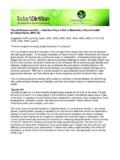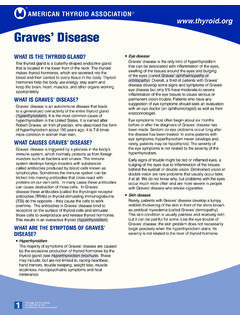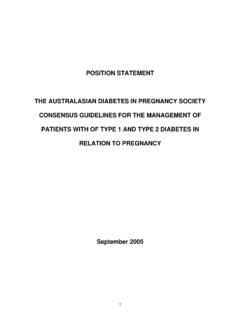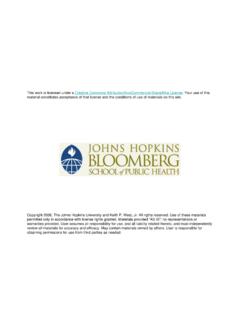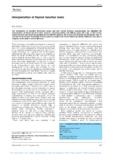Transcription of QUARTERLY MEDICAL REVIEW - Raptakos, Brett & …
1 QUARTERLY MEDICAL REVIEW Vol. 59, No. 1 January March 2008 THYROID DISORDERS CONTENTS 1. Introduction .. 4 2. Thyroid Disorders .. 7 3. Hypothyroidism .. 7 4. Hyperthyroidism .. 11 5. Goiter .. 14 6. Thyroid Carcinoma.
2 19 QUARTERLY MEDICAL REVIEW Vol. 59, No. 1 January March 2008 THYROID DISORDERS Dr. Prakash P. Shilotri, , , Professor and Head Dept. of General Surgery and Endocrine Surgery, Topiwala National MEDICAL College & Nair Charitable Hospital, Dr. Nair Rioad, MUMBAI 400 008. Tel. : (022) 2308 1490 Extn. 146 An estimated 108 million people in India suffer from endocrine and metabolic disorders, with the poor mainly bearing the brunt of the disease .
3 Several of these diseases are caused by environmental factors, are preventable and can be also effectively treated at affordable cost. Yet a majority of them remain undiagnosed and untreated due to the lack of technology use. Recent estimates indicate that 800 million to one billion people are exposed to insufficient supply of iodine. At least 200 million have goiter. These conservative figures also include large industrialized countries. Disorders of Thyroid Gland in India Disorders of thyroid hormone metabolism are commonly encountered in clinical practice. Thyroid disorders are the most common among all the endocrine diseases in India.
4 Though endemic goiter and related problems of human health and development caused by nutritional iodine deficiency were thought to be confined to Himalayan and sub-Himalayan regions, isolated studies by independent investigators as well as a multi-centric national study by the Indian Council of MEDICAL Research in the eighties showed country-wide prevalence of endemic goiter. Iodine deficiency disorders were widely prevalent in Indian subcontinent before the successful salt iodisation. Till 1973, it was believed that goitrous enlargement of the thyroid in iodine-deficient populations was adaptive in nature resulting in functional euthyroidism in all but exceptional situations.
5 However, AIIMS scientists showed that majority of the subjects with larger grades of goiter were functionally de-compensated and hypothyroid in severely iodine-deficient regions. These observations, confirmed subsequently by several workers in other endemic regions of the world, helped focus attention on the serious nature of nutritional iodine deficiency as a health problem. Currently there is national and international recognition that successful salt iodation has virtually eliminated nutritional iodine deficiency in the country. Studies done to assess the impact of salt iodation on incidence of neonatal hypothyroidism in the same districts, where pre-salt iodation studies were done, showed remarkable decline in the incidence from a 100/1000 birth to less than 18/1000 birth.
6 The salt iodation programme is thus saving millions from neonatal hypothyroidism-related mental retardation and other iodine deficiency disorders in the country. There are several other functional disorders of thyroid found in the country. Thus, thyrotoxicosis is a widely prevalent disorder of the thyroid in north India. Recently a countrywide study was done to assess the prevalence of common thyroid disorders in the post salt-iodation phase among school children, NCC cadets as well as army recruits from all over the country. The results of these studies, show 23% residual goiter prevalence among school children countrywide, with normalized urine iodine excretion, indicating elimination of nutritional iodine deficiency.
7 Functional studies of the goitrous subjects showed overall prevalence of hypothyroidism, hyperthyroidism. prevalence of autoimmune thyroiditis was demonstrable by fine needle aspiration biopsy among female goitrous students. On the basis of this countrywide study and other related studies, it can now be estimated that the total burden of significant thyroid disease in the country in the post salt-iodization phase is approximately 42 million. The profile of thyroid disorders encountered in pediatric and adolescent age groups in India is similar to that seen in most parts of the world except for the prevalence of iodine deficiency disorders in certain endemic regions of this country.
8 Clinical presentation is most commonly for hypothyroidism and goiters and infrequently for hyperthyroidism. Thyroid disorders are common endocrine problems encountered in the paediatric and adolescent age group. Amongst the functional thyroid disorders hypothyroidism is far more common than hyperthyroidism. Though simple goitre is common in this age group, nodular goitre and in particular solitary thyroid nodules are uncommon. Functional thyroid disorders lend themselves to effective treatment and monitoring strategies. The Thyroid Hormones The principal role of the thyroid gland is to regulate tissue metabolism by producing the thyroid hormones 3,5, 3 , 5 -tetra-iodo-L-thyronine (levothyroxine, L-thyroxine, T4) and, in smaller amounts, 3,5, 3 -tri-iodo-L-thyronine (liothyronine, triiodothyronine; T3).
9 In infants and children thyroid hormones are also necessary for the development of the CNS and for normal growth and bone maturation. The production of thyroid hormones depends on an adequate supply of dietary iodine. Iodine is reduced to iodide in the gastrointestinal tract and is then readily absorbed and actively transported into the thyroid gland. Oxidized iodide is incorporated into the glycoprotein thyroglobulin to form L-mono-iodotyrosine (MIT) and L-di-iodotyrosine (DIT), which are inactive. The hormonally active iodithyronines are formed by a coupling reaction T3 and T4. These are joined by a peptide bond to thyroglobulin and stored in the follicular colloid.
10 The thyroglobulin is degraded to release T3 and T4 into the circulation; iodide resulting from this reaction is recycled. Whereas T4 enters the circulation only by direct glandular secretion, most of the T3 in the body is produced by the mono-deiodination of T4 in the peripheral tissues. Thyroid hormone homoeostasis is maintained by autoregulatory mechanisms within the gland, and by the hypothalamic-pituitary-thyroid axis. In response to falling plasma concentrations of T3 and T4, the hypothalamus secretes thyrotropin releasing hormone (protirelin; TRH). TRH stimulates the synthesis and release of thyroid stimulating hormone (thyrotropin; TSH) by the anterior pituitary gland.
